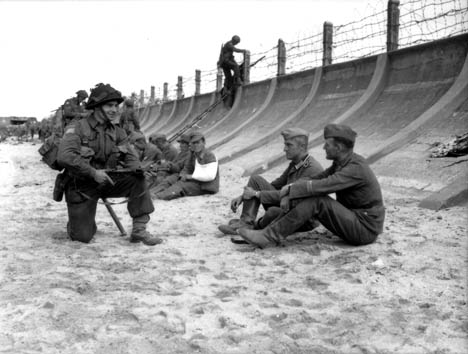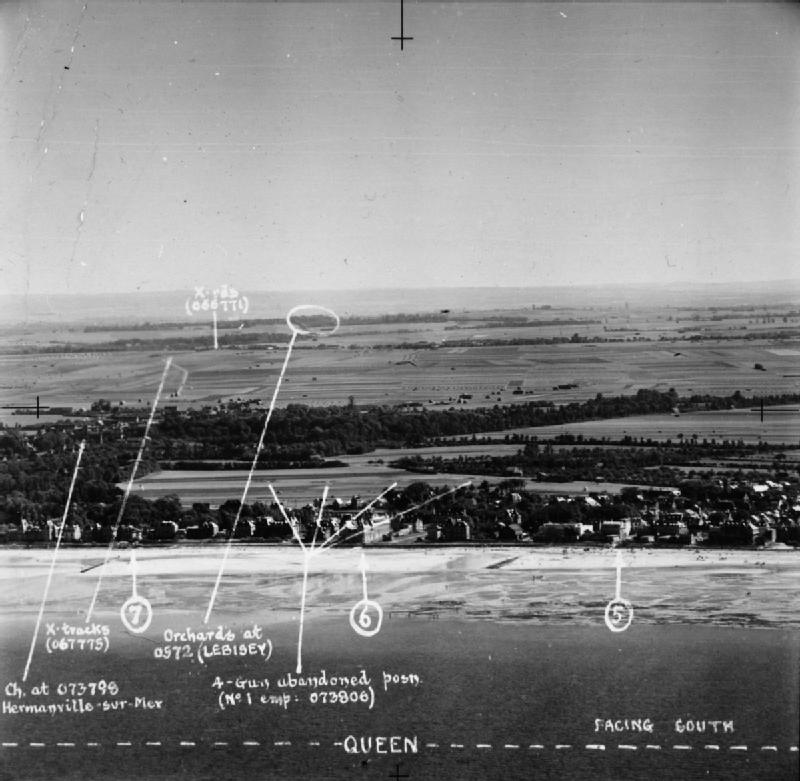|
716th Infantry Division (Wehrmacht)
The 716th Static Infantry Division (German: ''716. Infanterie-Division'') was a World War II, German Army infantry division. It was raised on May 2, 1941, and sent to German-occupied France in June 1941. Many of the division's troops were elderly Germans and conscripts from other German-occupied countries, especially Ukrainians. The division also had some young German conscripts as well. As a ''bodenständig'' (static unit) it was not equipped with the standard configuration of vehicles and heavy weapons. Much of the division's artillery and anti-tank guns were from captured armaments. It is well-known for its involvement as a defensive unit in the Allied Normandy landings on 6 June 1944 (often called "D-Day"). Divisional history The 716.Infanterie-Divisionen was mobilized for occupation duties in the 15.Welle (Wave) Replacement Army on 2 May 1941 in Wehrkreis VI in Munster. After formation in Bielefeld, and transfer to Occupied France, it was assigned to AOK 15 in June 194 ... [...More Info...] [...Related Items...] OR: [Wikipedia] [Google] [Baidu] |
German Army (Wehrmacht)
The German Army (, "army") is the land component of the armed forces of Federal Republic of Germany, Germany. The present-day German Army was founded in 1955 as part of the newly formed West German ''Bundeswehr'' together with the German Navy, ''Marine'' (German Navy) and the German Air Force, ''Luftwaffe'' (German Air Force). , the German Army had a strength of 62,766 soldiers. History Overview A German army equipped, organized, and trained following a single doctrine and permanently unified under one command in 1871 during the unification of Germany under the leadership of Prussia. From 1871 to 1919, the title ''German Army (German Empire), Deutsches Heer'' (German Army) was the official name of the German land forces. Following the German defeat in World War I and the end of the German Empire, the main army was dissolved. From 1921 to 1935 the name of the German land forces was the ''Reichswehr, Reichsheer'' (Army of the Empire) and from 1935 to 1945 the name ''German Army (We ... [...More Info...] [...Related Items...] OR: [Wikipedia] [Google] [Baidu] |
Brussels
Brussels (french: Bruxelles or ; nl, Brussel ), officially the Brussels-Capital Region (All text and all but one graphic show the English name as Brussels-Capital Region.) (french: link=no, Région de Bruxelles-Capitale; nl, link=no, Brussels Hoofdstedelijk Gewest), is a region of Belgium comprising 19 municipalities, including the City of Brussels, which is the capital of Belgium. The Brussels-Capital Region is located in the central portion of the country and is a part of both the French Community of Belgium and the Flemish Community, but is separate from the Flemish Region (within which it forms an enclave) and the Walloon Region. Brussels is the most densely populated region in Belgium, and although it has the highest GDP per capita, it has the lowest available income per household. The Brussels Region covers , a relatively small area compared to the two other regions, and has a population of over 1.2 million. The five times larger metropolitan area of Brusse ... [...More Info...] [...Related Items...] OR: [Wikipedia] [Google] [Baidu] |
French Resistance
The French Resistance (french: La Résistance) was a collection of organisations that fought the German occupation of France during World War II, Nazi occupation of France and the Collaborationism, collaborationist Vichy France, Vichy régime during the World War II, Second World War. Resistance Clandestine cell system, cells were small groups of armed men and women (called the Maquis (World War II), Maquis in rural areas) who, in addition to their guerrilla warfare activities, were also publishers of underground newspapers, providers of first-hand intelligence information, and maintainers of escape networks that helped Allies of World War II, Allied soldiers and airmen trapped behind enemy lines. The Resistance's men and women came from all economic levels and political leanings of French society, including émigrés, academics, students, Aristocratic family, aristocrats, conservative Catholic Church, Roman Catholics (including priests and Yvonne Beauvais, nuns), Protestantis ... [...More Info...] [...Related Items...] OR: [Wikipedia] [Google] [Baidu] |
Lyon
Lyon,, ; Occitan: ''Lion'', hist. ''Lionés'' also spelled in English as Lyons, is the third-largest city and second-largest metropolitan area of France. It is located at the confluence of the rivers Rhône and Saône, to the northwest of the French Alps, southeast of Paris, north of Marseille, southwest of Geneva, northeast of Saint-Étienne. The City of Lyon proper had a population of 522,969 in 2019 within its small municipal territory of , but together with its suburbs and exurbs the Lyon metropolitan area had a population of 2,280,845 that same year, the second most populated in France. Lyon and 58 suburban municipalities have formed since 2015 the Metropolis of Lyon, a directly elected metropolitan authority now in charge of most urban issues, with a population of 1,411,571 in 2019. Lyon is the prefecture of the Auvergne-Rhône-Alpes region and seat of the Departmental Council of Rhône (whose jurisdiction, however, no longer extends over the Metropolis of Lyo ... [...More Info...] [...Related Items...] OR: [Wikipedia] [Google] [Baidu] |
Languedoc
The Province of Languedoc (; , ; oc, Lengadòc ) is a former province of France. Most of its territory is now contained in the modern-day region of Occitanie in Southern France. Its capital city was Toulouse. It had an area of approximately 42,700 square kilometers (16,490 square miles). History The Roman province of Gallia Narbonensis fell to the Visigothic Kingdom from the 5th to the 8th centuries. Occupied briefly by the Emirate of Córdoba between 719 and 759, it was conquered and incorporated into the Kingdom of the Franks by Pippin the Short in 759 following the Siege of Narbonne. Under the Carolingians, the counts of Toulouse were appointed by the royal court. Later, this office became hereditary. Part of the territory where Occitan was spoken came to be called ''langue d'oc'', ''Lengadòc'' or Languedoc. In the 13th century, the spiritual beliefs of the area were challenged by the See of Rome and the region became attached to the Kingdom of France following the ... [...More Info...] [...Related Items...] OR: [Wikipedia] [Google] [Baidu] |
France–Spain Border
The France–Spain border (; ) was formally defined in 1659. It separates the two countries from Hendaye and Irun in the west, running through the Pyrenees to Cerbère and Portbou on the Mediterranean Sea. Features Main border The Franco-Spanish border runs for between southwestern France and northeastern Spain. It begins in the west on the Bay of Biscay at the French city of Hendaye and the Spanish city of Irun (). The border continues eastward along the Pyrenees to Andorra (). At this point, the small country interrupts the border between Spain and France for on the Spanish side and on the French side. Then the border continues eastward () to the Mediterranean Sea at Cerbère in France and Portbou in Spain (). From west to east, crossing the border: * Spain ** Gipuzkoa ( Basque Country) ** Navarre ** Province of Huesca (Aragon) ** Province of Lleida (Catalonia) ** Province of Girona (Catalonia) * France ** Pyrénées-Atlantiques (Nouvelle-Aquitaine) ** Hautes-Pyrénées ( ... [...More Info...] [...Related Items...] OR: [Wikipedia] [Google] [Baidu] |
Southern France
Southern France, also known as the South of France or colloquially in French language, French as , is a defined geographical area consisting of the regions of France that border the Atlantic Ocean south of the Marais Poitevin,Louis Papy, ''Le midi atlantique'', Atlas et géographie de la France moderne, Flammarion, Paris, 1984. Spain, the Mediterranean Sea and Italy. It includes southern Nouvelle-Aquitaine in the west, Occitania (administrative region), Occitanie in the centre, the southern parts of Auvergne-Rhône-Alpes in the northeast, Provence-Alpes-Côte d'Azur in the southeast, as well as the island of Corsica in the southeast. Southern France is generally included into Southern Europe because of its association with the Mediterranean Sea. The term derives from ('middle') and ('day') in Old French, comparable to the term to indicate southern Italy, which is a synonym for south in Romanian language, Romanian, or which is a synonym for the south direction in Spanish langu ... [...More Info...] [...Related Items...] OR: [Wikipedia] [Google] [Baidu] |
Villers-Bocage, Calvados
Villers-Bocage () is a commune in the Calvados department in the Normandy region in Northern France. History Second World War The Battle of Villers-Bocage was a significant battle between British and German forces on 13 June 1944 during the Battle of Normandy.Daniel Taylor: ''Villers-Bocage through the Lens''. 1999, . Further fighting occurred two weeks later during Operation Epsom, during which the village was destroyed by 250 RAF heavy bombers. Population International relations The commune is twinned with: * Bampton, Devon, UK since 1974 See also *Communes of the Calvados department The following is a list of the 528 communes of the Calvados department of France. The communes cooperate in the following intercommunalities (as of 2020): [...More Info...] [...Related Items...] OR: [Wikipedia] [Google] [Baidu] |
6th Airborne Division (United Kingdom)
The 6th Airborne Division was an airborne infantry division of the British Army during the Second World War. Despite its name, the 6th was actually the second of two airborne divisions raised by the British Army during the war, the other being the 1st Airborne Division. The 6th Airborne Division was formed in the Second World War, in mid-1943, and was commanded by Major-General Richard N. Gale. The division consisted of the 3rd and 5th Parachute Brigades along with the 6th Airlanding Brigade and supporting units. The division's first mission was Operation Tonga on 6 June 1944, D-Day, part of the Normandy landings, where it was responsible for securing the left flank of the Allied invasion during Operation Overlord. The division remained in Normandy for three months before being withdrawn in September. The division was entrained day after day later that month, over nearly a week, preparing to join Operation Market Garden but was eventually stood down. While still recruiti ... [...More Info...] [...Related Items...] OR: [Wikipedia] [Google] [Baidu] |
Sword Beach
Sword, commonly known as Sword Beach, was the code name given to one of the five main landing areas along the Normandy coast during the initial assault phase, Operation Neptune, of Operation Overlord. The Allied invasion of German-occupied France commenced on 6 June 1944. Stretching from Ouistreham to Saint-Aubin-sur-Mer, the beach proved to be the easternmost landing site of the invasion after the abortion of an attack on a sixth beach, code-named Band. Taking Sword was to be the responsibility of the British Army with sea transport, mine sweeping and a naval bombardment force provided by the British Royal Navy as well as elements from the Polish, Norwegian and other Allied navies. Among the five beaches of the operation, Sword is the nearest to Caen, about from the goal of the 3rd Infantry Division. The landings were achieved with low Allied casualties but the advance from the beach was slowed by traffic congestion and resistance in defended areas behind the beach. Furthe ... [...More Info...] [...Related Items...] OR: [Wikipedia] [Google] [Baidu] |
Juno Beach
Juno or Juno Beach was one of five beaches of the Allied invasion of German-occupied France in the Normandy landings on 6 June 1944 during the Second World War. The beach spanned from Courseulles, a village just east of the British beach Gold, to Saint-Aubin-sur-Mer, and just west of the British beach Sword. Taking Juno was the responsibility of the Canadian Army, with sea transport, mine sweeping, and a naval bombardment force provided by the Royal Canadian Navy and the British Royal Navy as well as elements from the Free French, Norwegian, and other Allied navies. The objectives of the 3rd Canadian Infantry Division on D-Day were to cut the Caen-Bayeux road, seize the Carpiquet airport west of Caen, and form a link between the two British beaches on either flank. The beach was defended by two battalions of the German 716th Infantry Division, with elements of the 21st Panzer Division held in reserve near Caen. The invasion plan called for two brigades of the 3rd Canadi ... [...More Info...] [...Related Items...] OR: [Wikipedia] [Google] [Baidu] |

.jpg)


